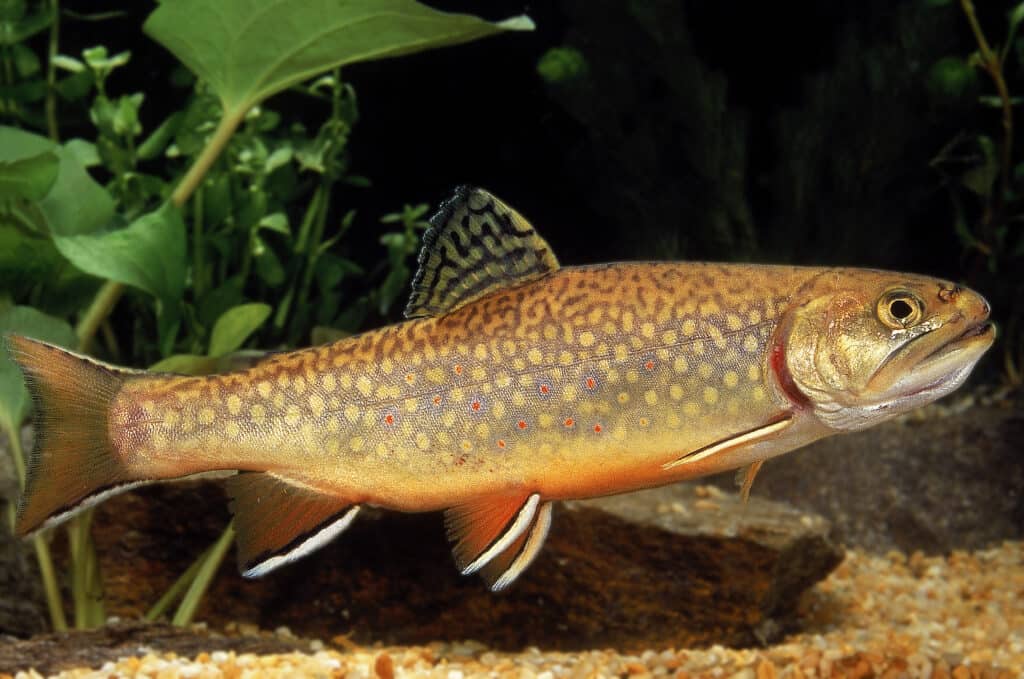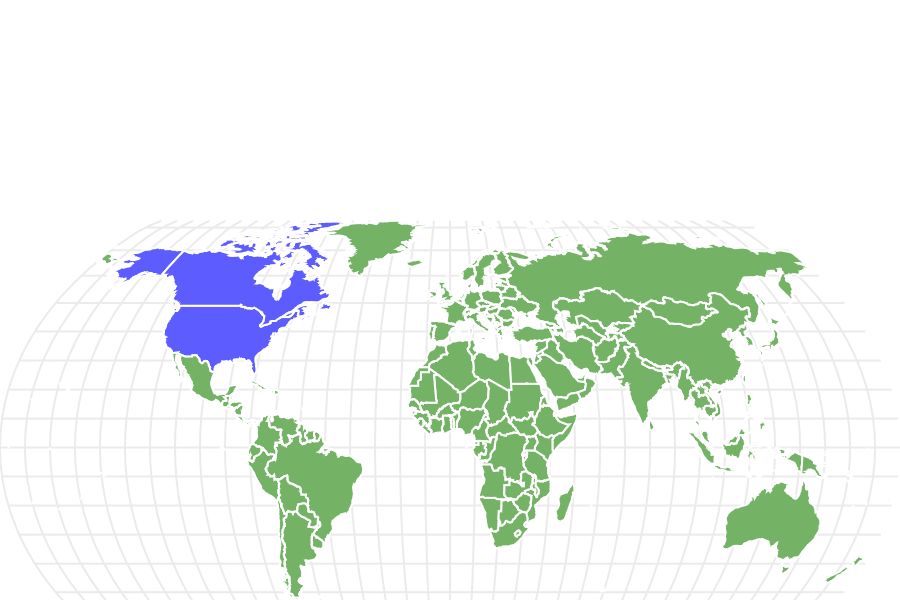Brook Trout
S. forntinalis
The Brook Trout is actually part of the salmon family, making it not technically a trout.
Advertisement
Brook Trout Scientific Classification
- Kingdom
- Animalia
- Phylum
- Chordata
- Class
- Actinopterygii
- Order
- Salmoniformes
- Family
- Salmonidae
- Genus
- Salvelinus
- Scientific Name
- S. forntinalis
Read our Complete Guide to Classification of Animals.
Brook Trout Conservation Status
Brook Trout Facts
- Prey
- Opportunistic
- Main Prey
- insects, amphibians, invertebrates, minnows, and other smaller fish
- Name Of Young
- Fry
- Group Behavior
- Solitary
- Group
- Fun Fact
- The Brook Trout is actually part of the salmon family, making it not technically a trout.
- Biggest Threat
- Human Development
- Other Name(s)
- Speckled Trout, Brook Char, Coaster Trout
- Gestation Period
- 90-100 days
- Optimum pH Level
- 6.5-8.0
- Incubation Period
- 41-44 days
- Age Of Independence
- two years
- Average Spawn Size
- 100-400eggs
- Predators
- Snakes, Heron, Kingfishers, Otters, Snapping Turtles
- Diet
- Carnivore
- Location
- North America
Brook Trout Physical Characteristics
- Color
- Yellow
- Red
- Gold
- Orange
- Olive-Grey
- Golden
- Skin Type
- Scales
- Lifespan
- Up to 6 years
- Weight
- 1-7 pounds
- Length
- 10-25 inches
- Age of Sexual Maturity
- Two-three years
- Venomous
- No
- Aggression
- Low
View all of the Brook Trout images!
“This popular fish is a star in recreational fishing” sums up the feeling anglers have about the Brook Trout.
Brook Trout is a freshwater fish native to Eastern North America, specifically the northern areas of the United States and Canada. It is a popular sport fish, especially for fly fishermen.
It lives in cool, clear water in remote and mountainous areas. Also known as the speckled trout, it has unique coloring with yellow spots over an olive-green background, transitioning to orange and red along its sides and belly.
5 Brook Trout Facts
- Brook Trout is the state fish of nine states in the United States: Michigan, New Hampshire, New Jersey, New York, North Carolina, Pennsylvania, Vermont, Virginia, and West Virginia.
- Some Brook Trout called “salters” along the Atlantic coast will travel into the ocean to feed for months at a time. In the ocean, they lose their color somewhat and turn to more of a silver color. Once they return to freshwater to spawn, their color returns within 2 weeks.
- Brook Trout only thrive in the cleanest and coldest freshwater streams and rivers. They can be used as a good indicator of the purity of the water.
Brook Trout Classification and Scientific name
The scientific name for Brook Trout is Salvelinus fontinalis. “Fontinalis” comes from Latin for “of a spring or fountain.” This is about the cool, clear water where the Brook Trout thrive.
They are in the Order Salmoniformes, and the family Salmonidae. This family, known as Salmonoids, includes salmon, trout, char, and freshwater whitefish. They all spawn in freshwater, but many spend most of their life feeding in saltwater.
Types of Brook Trout: The “Ecological” Forms
While Brook Trout does not have multiple species, they adapt to different ecological forms depending on their environment. They grow at different rates and act differently, though they have the same appearance.
Robert J. Behnke described three different forms in his landmark book:
- Large Lake – These Brook Trout are in the larger lakes in the northern extremes of the United States and Canada, and can grow larger than in other areas. They mainly feed on other smaller fish.
- Sea-Run or Salters – These Brook Trout migrate to salt water along the Atlantic coastline for short periods to feed.
- Small Generalist – Lives in small lakes, ponds, streams, and rivers, and rarely grows larger than 12 inches, and has a shorter life span than others, typically less than 3 years.
Brook Trout Appearance
Brook Trout have a dark olive green color with lighter yellow dots or speckles. Their body is wide in the middle and tapers to both ends. Its head has a large mouth and a rounded snout.
They have a marbled pattern along their back, also called vermiculation. The belly and lower fins are orange-reddish, with the fins having a white leading edge. Full-grown lengths can vary between 10 to 25 inches and weigh between 0.6 to 6.6 pounds. However, most fishermen catch fish that are much smaller.
The world record was caught in 1915 in Ontario and was 31 inches long.

The Brook Trout has a speckled appearance, which is known to fade if they spend time in salt water.
©Slowmotion GLI/Shutterstock.com
Brook Trout Distribution, Population, and Habitat
Brook trout can be found in cool, clear freshwater streams, rivers, and lakes in the eastern United States and Canada. These fish were established in their native areas before the 19th century due to the clear, undisturbed water.
As the land around the native areas developed, the water became polluted from runoff, streams were dammed, or the water was silted. When the water became too warm from silt or algae growth from fertilizer runoff, the Brook Trout did not thrive and, in some areas, was extirpated.
Brook Trout is generally not considered threatened in remote areas where they are well established. Sport fisherman will typically catch them with a fly rod during the mornings or evenings when they are most active.
Brook Trout can also be found in the northern Rocky Mountains, where they are considered invasive. They were introduced here outside of their native range and are a threat to the native cutthroat trout. In some areas of Yellowstone National Park, anglers may take an unlimited number of Brook Trout.
In the Lamar River, it is required to kill any Brook Trout caught and not return them to the water.
Brook Trout Predators and Prey
Brook Trout are opportunistic feeders, and their diet is diverse. Aquatic insects such as mayflies, stoneflies, and caddisflies are preferred.
They will also eat land-based insects, amphibians, smaller fish, and almost any other animal in the water that is smaller than them, even young Brook Trout. Predators are typical of other fish, including larger fish and birds.
What Eats Brook Trout?
Predators include heron, kingfishers, otters, snapping turtles, snakes, and other larger fish.
What Do Brook Trout Eat?
Their typical diet includes insects, amphibians, invertebrates, minnows, and other smaller fish; almost anything they can fit in their mouth.
Brook Trout Reproduction and Lifespan
Brook Trout will spawn in the fall, from October to early November. The female will create a shallow, “redd” nest in a clean area with small gravel or stones. She will lay around 100-400 eggs, and multiple males will fertilize the eggs.
The female will then bury the eggs with the gravel. The eggs will remain over the winter and hatch about 90-100 days later in the spring. These fish will mature in about 2 to 3 years and typically live about 6 years.
Brook Trout in Fishing and Cooking
Brook Trout are a popular fish for both sport fisherman and raising commercially. The meat is light and delicate and has a slightly sweet flavor compared to other trout. They are most popular in their native regions. However, they are commercially sold as smoked trout in many areas.
Since Brook Trout require cool, clear water, they are usually found in remote mountainous areas, which can be challenging to reach. They reside in mountain streams and rivers and congregate in small areas where the water flow is slow, along the back side of boulders.
They can be caught with spinning rods with light tackle, but the most popular is with a fly rod. With fly fishing, targeting these small areas where Brook Trout rests in slower water is easier.
Brook Trout can be prepared in many ways, from grilled, braised, and pan-fried. Because of its delicate flavoring, minimal seasoning is needed.
Since they are usually small, panfrying them whole is the most popular way. A 3-ounce serving contains 18 grams of protein and 2.3 grams of fat.
Similar Animals
View all 285 animals that start with BBrook Trout FAQs (Frequently Asked Questions)
Where are Brook Trout Found?
Brook trout are found in the Eastern United States and Canada in cool, clear freshwater streams in remote areas away from much development.
Thank you for reading! Have some feedback for us? Contact the AZ Animals editorial team.
Sources
- Wikipedia, Available here: https://en.wikipedia.org/wiki/Brook_trout
- National Wildlife Federation, Available here: https://www.nwf.org/Educational-Resources/Wildlife-Guide/Fish/Brook-Trout
- US Fish & Wildlife Service, Available here: https://www.fws.gov/species/brook-trout-salvelinus-fontinalis
- Meateater, Available here: https://www.themeateater.com/fish/freshwater/how-to-catch-and-eat-the-delectable-brook-trout

















